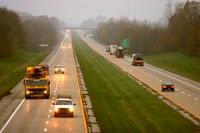 In 2009, the United States Congress will be due for passage of another 6-year bill authorizing federal transportation spending. The federal transportation bill sets both funding targets and federal transportation policy. Rather than a simple reauthorization of existing policy, the 2009 bill is expected to be a turning point for new policies and funding formulas, in recognition of the urgency of national needs-- everything from obesity prevention, escalating fuel prices, the need for energy independence from Middle East oil, the battle against global climate change, to the aging infrastructure of America's roadways and bridges.
In 2009, the United States Congress will be due for passage of another 6-year bill authorizing federal transportation spending. The federal transportation bill sets both funding targets and federal transportation policy. Rather than a simple reauthorization of existing policy, the 2009 bill is expected to be a turning point for new policies and funding formulas, in recognition of the urgency of national needs-- everything from obesity prevention, escalating fuel prices, the need for energy independence from Middle East oil, the battle against global climate change, to the aging infrastructure of America's roadways and bridges.This could be the most significant reauthorization since the President Dwight D. Eisenhower created the National Interstate and Defense Highway Act in 1956. This act created much of the world we live in today-- including many of the urgent needs that will impact the new transportation bill.
In creating the 41,000 miles of Interstate highways, the act opened the door for

sprawling cities and suburban development and also the expanded carbon footprint. It led to the growth of increasing affordable single family dwellings and shopping malls ever farther from city centers, which in turn created an even greater dependence on automobiles. It ultimately led to the creation of a powerful industrial and employment base in the American automobile industry, and a dependence on foreign oil.
The reathorization of the transportation bill could usher in a new paradigm for transportation policy in the future in some of the following ways:
- Will the new legislation continue to promote an aggressive agenda for building new roads or will environmental issues and energy independence lead to a shift toward rail and mass transit connecting larger urban areas and airports?
- Will the new legislation allow states and metro areas more freedom in funding and prioritizing projects?
- The fuels tax that has funded the program since its inception can no longer serve as the sole source of revenue as people drive more fuel-efficient vehicles, how will the new legislation propose to fund transportation needs?
Owensboro missed the opportunity to be a part of the interstate network that was created in 1956. With the construction of Interstate 69, Owensboro will, after half a century, be a part of the this network. The reathorization will be critical in completing this task. Perhaps more critically, it is important not be on the wrong side of the pendulum as it swings toward a new paradigm as we are trying to play catch up with inclusion in the interstate highway network. If the pendulum swings toward mass transit and rail, we cannot afford to spend the next 50 years becoming a part of that system. We must present a compelling case for Owensboro being a part of an enhanced mass transit and rail network.
For example, this region has spent a lot of energy fighting for commercial air service to connect Owensboro to metro areas like Cincinnati, St. Louis, Nashville, or Louisville. Maybe high speed rail is the answer. Japan, China, and Europe have shown how effective this form of transportation is for travelers and commuters alike. It is a more environmentally-friendly model that lessens dependence on foreign oil. It could even use the low cost electricity generated in the region. A high speed rail link to just one major metro area could totally transform the region-- it would even be possible for professionals to work in that metro while enjoying the quality of life we love in Owensboro.
The reathorization of the next transportation bill is critical in completing the task of putting Greater Owensboro in the 20th century transportation network, but it is equally critical not to overlook the opportunities that lie ahead in making Owensboro a part of the 21st century transportation network that has yet to be constructed.
.png)